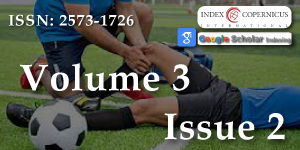Bergamot Polyphenolic Fraction supplementation improves metabolic balance, endothelial function and maximal oxygen uptake in athletes
Main Article Content
Abstract
Background: The study aimed to evaluate the effects of a 4-week Bergamot Polyphenolic Fraction (BPF Gold; Bergamet Sport) supplementation on serum nitric oxide (NO), asymmetric dimethyl-arginine (ADMA), Endopat indices of endothelial function and maximal oxygen uptake (V_ O2max) of athletes.
Methods: The effects of dietary supplementation (BPF Gold, 650 mg twice a day for 4 weeks) and placebo administration on flow-mediated dilatation (via Endopat measurements), serum markers (NO, ADMA), lipid profile, and V_ O2max were analysed in 30 athletes both before and after dietary protocols.
Results: Significant differences between pre- and post-intervention baseline NO levels were observed after BPF Gold dietary protocol. Higher post-intervention baseline NO level was observed after BPF Gold diet compared with placebo. Moreover BPF Gold Sport increased baseline NO concentration (ΔNO). The positive correlation was observed between baseline post-intervention NO concentration and maximal oxygen uptale and also between ΔNO and ΔVO2max in response to BPF Gold supplementation. There was an association between a higher Edopat values of endothelial function and higher V O2max after Bergamet Sport diet compared with lower values of placebo.
Conclusions: These findings suggest that an increase in NO release in response to BPF Gold Sport supplementation may play a central role in cardiovascular adaptive mechanisms and enhanced exercise performance in athletes.
Article Details
Copyright (c) 2018 Mollace R, et al.

This work is licensed under a Creative Commons Attribution-NonCommercial 4.0 International License.
Bell C. Cardiovascular adaptation to chronic exercise. In C. Bell (Ed.), cardiovascular physiology in exercise and sport. London: Churchill Livingstone. Elsevier Health Sciences. 2008; 129-142. Ref.: https://goo.gl/grMHCU
Jensen L, Bangsbo J, Hellsten Y. Effect of high intensity training on capillarization and presence of angiogenic factors in human skeletal muscle. J Physiology. 2004; 557: 571-582. Ref.: https://goo.gl/ocE7kC
Green DJ, Spence A, Rowley N, Thijssen DHJ, Naylor LH. Vascular adaptation in athletes: Is there an athlete’s artery? Exp Physiol. 2012; 97: 295-304. Ref.: https://goo.gl/cQci5H
Prior BM, Yang HT, Terjung RL. What makes vessels grow with exercise training? J Appl Physiol (1985). 2004; 97: 1119-1128. Ref.: https://goo.gl/8EEBvs
Celec P, Yonemitsu Y. Vascular endothelial growth factor-Basic science and its clinical implications. Pathophysiology. 2004; 1: 69-75. Ref.: https://goo.gl/5x6dcJ
Bailey SJ, Vanhatalo A, Winyard PG, Jones AM. The nitrate-nitrite-nitric oxide pathway: Its role in human exercise physiology. Eur J Sport Sci. 2012; 12: 309-320. Ref.: https://goo.gl/sPekwi
Bell C. Cardiovascular adaptation to chronic exercise. In C. Bell (Ed.). Cardiovascular physiology in exercise and sport. Elsevier Health Sciences. 2008; 29-142. Ref.: https://goo.gl/wzqafA
Calbet JA, Gonzalez-Alonso J, Helge JW, Søndergaard H, Munch-Andersen T, et al. Cardiac output and leg and arm blood flow during incremental exercise to exhaustion on cycle ergometer. J Appl Physiol (1985). 2007; 103: 969-978. Ref.: https://goo.gl/kQVjXm
Kalliokoski KK, Oikonen V, Takala TO, Sipilä H, Knuuti J, et al. Enhanced oxygen extraction and reduced flow heterogeneity in exercising muscle in endurancetrained men. Am J Physiol Endocrinol Metab. 2001; 280: 1015-1021. Ref.: https://goo.gl/xMknHU
Newcomer SC, Leuenberger UA, Hogeman CS, Handly BD, Proctor DN. Different vasodilator responses of human arms and legs. J Physiol. 2004; 556: 1001-1011. Ref.: https://goo.gl/aZtaHK
Fahs CA, Yan H, Ranadive S, Rossow L M, Agiovlasitis S, et al. The effect of acute fish-oil supplementation on endothelial function and arterial stiffness following a high-fat meal. Appl Physiol Nutr Metab. 2010; 35: 294-302. Ref.: https://goo.gl/38MhoX
Anderson JS, Nettleton JA, Herrington DM, Johnson WC, Tsai MY, et al. Relation of omega-3 fatty acid and dietary fish intake with brachial artery flow-mediated vasodilatation in the multi-ethnic study of atherosclerosis. Am J Clin Nutr. 2010; 92: 1204-1213. Ref.: https://goo.gl/Le8t1H
Khan F, Elherik K, Bolton-Smith C, Barr R, Hill A, et al. The effects of dietary fatty acid supplementation on endothelial function and vascular tone in healthy subjects. Cardiovasc Res. 2003; 59: 955-962. Ref.: https://goo.gl/dJCnPN
Juturu V. Omega-3 fatty acids and the cardiometabolic syndrome. J Cardiometab Syndr. 2008; 3: 244-253. Ref.: https://goo.gl/vmWeVs
Lovegrove JA, Griffin BA. The acute and long-term effects of dietary fatty acids on vascular function in health and disease. Curr Opin Clin Nutr Metab Care. 2013; 16: 162-167. Ref.: https://goo.gl/Y82BA2
Wang Q, Liang X, Wang L, Lu X, Huang J, et al. Effect of omega-3 fatty acids supplementation on endothelial function: A meta-analysis of randomized controlled trials. Atherosclerosis. 2012; 221: 536-543. Link: https://goo.gl/7xBEX5
Mollace V, Sacco I, Janda E, Malara C, Ventrice D et al. Hypolipemic and hypoglycemic activity of bergamot polyphenols: from animal models to human studies. Fitoterapia. 2011; 82: 309-316. Ref.: https://goo.gl/qR4s8J
Gliozzi M, Walker R, Muscoli S, Vitale C, Gratteri S, et al. Bergamot Polyphenolic fraction enhances rosuvastatin-induced effect on LDL-cholesterol, LOX-1 expression and protein kinase B phosphorylation in patients with hyperlipidemia. Int J Cardiol. 2013; 170: 140-145. Ref.: https://goo.gl/Kpqy7c
Gliozzi M, Carresi C, Musolino V, Palma E, Muscoli C, et al. The effect of nonalcoholic. 2014; 4: 129-137.
Parafati M, Lascala A, Morittu VM, Trimboli F, Rizzuto A, et al. Bergamot polyphenol fraction prevents nonalcoholic fatty liver disease via stimulation of lipophagy in cafeteria diet-induced rat model of metabolic syndrome. J Nutr Biochem. 2015; 26: 938-948. Ref.: https://goo.gl/9zoMXV
Delp MD. Effects of exercise training on endothelium-dependent peripheral vascular responsiveness. Med Sci Sports Exerc. 1995; 27: 1152-1157. Ref.: https://goo.gl/N9AFQp
Bailey SJ, Vanhatalo A, Winyard PG, Jones AM. The nitrate-nitrite-nitric oxide pathway: Its role in human exercise physiology. Eur J Sport Sci. 2012; 12: 309-320. Ref.: https://goo.gl/GY21dF
Kojda G, Hambrecht R. Molecular mechanisms of vascular adaptation to exercise. Physical activity as an effective antioxidant therapy? Cardiovasc Res. 2005; 67: 187-197. Ref.: https://goo.gl/SGy7SY
Trinity JD, Groot HJ, Layec G, Rossman MJ, Ives SJ, et al. Nitric oxide and passive limb movement: A new approach to assess vascular function. J Physiol. 2012; 590: 1413-1425. Ref.: https://goo.gl/Q4hqmD
Zebrowska A, Mizia-Stec K, Mizia M, Gąsior Z, Poprzęcki S. Omega-3 fatty acids supplementation improves endothelial function and maximal oxygen uptake in endurance-trained athletes. Eur J Sport Sci. 2015; 18: 215-225. Ref.: https://goo.gl/WPK7c6

